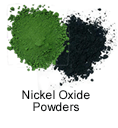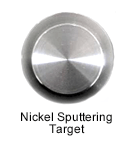Is "nickel" the only ingredient I need to worry about in terms of my nickel allergy? Or does it show up in other ingredients, and by other names? As I searched for these answers, I kept finding possible answers on sites for scientists, chemists. Well, I'm embarrassed to admit I never took chemistry class.
All these sites look like a foreign language to me. After changing my search terms a few times, I started to find some answers. And since it is a bit complicated, I'm copying and pasting the information along with links. I'm not going to pretend I've written this info. But I'm getting a better grasp on more names that will alert me to the presence of nickel and how to deal with nickel allergy.
Nickel is the only element named after the devil. The name comes from the German word Kupfernickel, meaning "Old Nick's copper," a term used by German miners. They tried to remove copper from an ore that looked like copper ore, but they were unsuccessful. Instead of copper, they got slag, a useless mass of earthy material. The miners believed the devil ("Old Nick") was playing a trick on them. So they called the fake copper ore Old Nick's copper.
Since then, nickel has become a very valuable metal. The most common use is in the production of stainless steel, a strong material that does not rust easily. It is used in hundreds of industrial and consumer applications. Nickel is also used in the manufacture of many other alloys. An alloy is made by melting and mixing two or more metals. The mixture has properties different from those of the individual metals.
Nickel is extensively alloyed with iron, chromium, molybdenum, and tungsten to produce stainless steel and other corrosion-resistant alloys. Nickel's high electrical conductivity lends itself to many electronics applications. For example, it is the basis of the nickel hydride battery and is an ideal component for ceramic anode formulations used in oxygen generation and solid oxide fuel cell
 applications. Nickel is also used as a pigment; its addition to
applications. Nickel is also used as a pigment; its addition to  glass and ceramic glazes results in a bright green color. Nickel is available as metal and compounds with purities from 99% to 99.999% (ACS grade to ultra-high purity). Elemental or metallic forms include pellets, rod, wire and granules for evaporation source material purposes. Nickel nanoparticles and nanopowders are also available. Nickel oxides are available in powder and dense pellet form for such uses as optical coating and thin film applications. Oxides tend to be insoluble. Nickel fluorides
are another insoluble form for uses in which oxygen is undesirable such
as metallurgy, chemical and physical vapor deposition and in some
optical coatings. Nickel is also available in soluble forms including chlorides, nitrates and acetates. These compounds can be manufactured as solutions at specified stoichiometries.
glass and ceramic glazes results in a bright green color. Nickel is available as metal and compounds with purities from 99% to 99.999% (ACS grade to ultra-high purity). Elemental or metallic forms include pellets, rod, wire and granules for evaporation source material purposes. Nickel nanoparticles and nanopowders are also available. Nickel oxides are available in powder and dense pellet form for such uses as optical coating and thin film applications. Oxides tend to be insoluble. Nickel fluorides
are another insoluble form for uses in which oxygen is undesirable such
as metallurgy, chemical and physical vapor deposition and in some
optical coatings. Nickel is also available in soluble forms including chlorides, nitrates and acetates. These compounds can be manufactured as solutions at specified stoichiometries.http://www.americanelements.com/ni.html
Stainless steels
The majority of the stainless steels contain 8-10% nickel. In all cases it is the combination of chromium with the nickel that does the job. Stainless steels are also useful as fire retardant materials since they retain their strength to higher temperatures than structural steel.The most common stainless steel is the 304 grade with 8% nickel and 18% chromium and the balance iron. This is used for such common items as spoons and forks, saucepans and kitchen sinks. Where extra corrosion resistance is required, such as for roofing in marine applications, type 316 is used. This has about the same amount of nickel and chromium as 304 but with 3% of molybdenum added. The balance is again iron.
There are many other stainless steels to cover the wide spectrum of demands of engineers and architects such as nickel plated steel (NPS).
Nickel Copper Alloys
These nickel copper alloys are sometimes referred to as MONEL or NICORROS and contain nickel with copper and small amounts of iron and manganese. A typical nickel copper alloy is the 400 grade (UNS N04400). This nickel copper alloys contains 63% nickel minimum, 28-34% copper, and a maximum of 2% manganese and 2.5% iron. There are also a small number of impurities kept at limited values to ensure the metal's properties are not harmed.These nickel copper alloys are used where a higher strength is required compared to pure nickel. Nickel copper alloys have a wider range of environments where they resist corrosion but in some specialised applications, such as strong alkali contaminant, nickel or commercially pure nickel would be superior.
Nickel copper alloys find wide application in oil refining and marine applications where long corrosion-free life is required. Because of good thermal conductivity of nickel copper alloys, they are frequently are used for heat exchangers where sea water is one of the fluids concerned.
Nickel Chromium Base Alloys
These nickel chromium base alloys are used extensively in applications where heat resistance and/or corrosion resistance is required. In some members of the group, where conditions are less demanding, some nickel is replaced by iron to decrease the overall cost.Metals fail at high temperatures by both oxidation (scaling) and through a loss in strength. Alloys in this class are designed to resist failure from both of these mechanisms. Nickel alloys are not suitable for high temperature sulphur rich environments.
Where corrosion resistance is significant, molybdenum is used as an alloying addition in nickel chromium based alloys.
This group of alloys are frequently sold under trade name specifications but most are listed in the Unified Numbering System. Common trade names are HASTELLOY, INCOLOY, INCONEL, NICROFER, NICROM and NIMONIC.
The more recentnickel chromium base alloys in these groups also have a wide range of ancillary elements added to give special properties - some of these can be quite complicated and require very close control over composition and heat treatment.
Trade Names and Owners of Nickel Alloys
HASTELLOY is a registered trade name of Haynes Intl.INCOLOY, INCONEL, MONEL and NIMONIC are registered trade names of the INCO family of companies.
INVAR is a registered trademark of Imphy S.A.
MU-METAL is a registered trademark of Telcon Metals Ltd
NICORROS and NICROFER are registered tradenames of Krupp UM GmbH
http://www.nickel-alloys.net/nickelalloys.html


